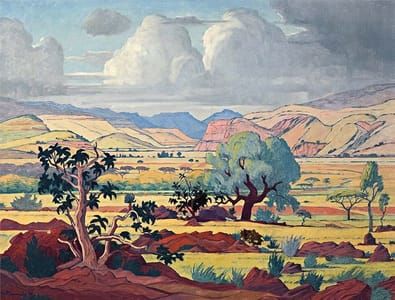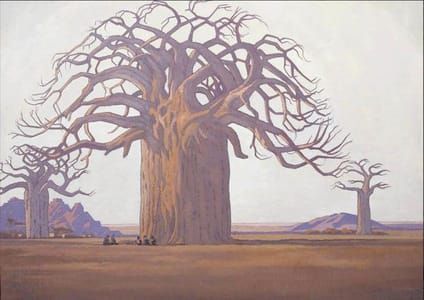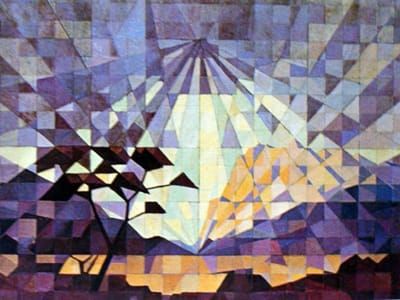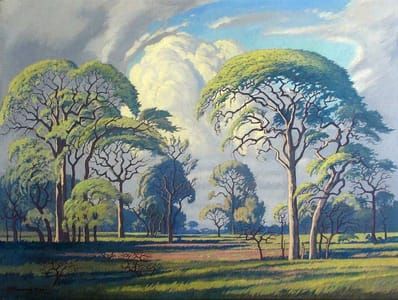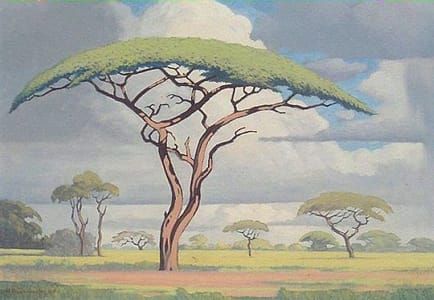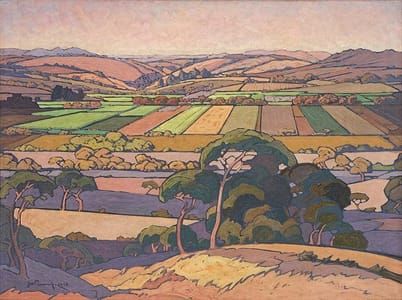

Composition in Blue, 1928
Jacobus Hendrik Pierneef
Composition in Blue is one of Pierneef’s more abstracted and heavily stylized works that was rejected by the public and after which he reverted back to a more representational style. In this painting he has taken his favourite Highveld landscape, trees and clouds, and fragmented it into geometric forms using a limited palette of color, reminiscent of the Cubist style, but he used the Cubist style to describe the illusion of reality and used it for a different aim.
The eye is drawn to the central source of light in the clouds and then back to the tree in the center of the composition, from where your eye is guided by the other trees deeper into the background and back up the the mountains into the sky. The dark vertical shapes of the trees diminishing in size almost forms a path that rhythmically leads the eye into the painting.
It is composed according to strict mathematical principles and philosophy where the cosmos is seen as a geometrically ordered whole and the artist is seen as striving to make the rules of this higher reality visible through mathematics.
The composition is divided into the golden thirds both by the vertical and horizontal lines as well as by his use of colour. In the foreground the warm color of the earth is divided into thirds horizontally by bands of purple-brown and ochre. The background and the middle ground forms a harmonious whole in graded blues divided into thirds by the horizontal lines of the trees emphasized by the tonal values of the blues. The strongly emphasized horizontal lines in this painting can be seen as a visual expression of the words of the national anthem. Die Stem:
Uit die blou van onse hemel, (From the blue of our heaven)
Uit die diepte van ons see, (From the depths of our sea)
Oor ons ewige gebergtes, (Over our eternal mountains)
Waar die kranse antwoord gee, (Where the cliffs echoes answers)
If you took away the strong contrasting vertical lines of the trees, especially the one in the foreground, however, the painting would lack the drama.
To Pierneef, the clouds symbolically represented “clouds of our Dear Lord,” an omnipresent creative force. In the center of the composition is the umbrella shaped Camelthorn tree. To Pierneef the tree is not simply a natural object, it was a means of expression, thought, and a feeling.To Pierneef the tree was both a psychological projection of man and a symbol of life, forming a link between heaven and earth. In this painting, the dominating tree is both a symbolic link between heaven and earth and a stylistic device that links the sky of the background to the earth in the foreground. The leadwood tree in particular was a symbol of eternity to him, and the Camelthorn symbolized the Bushveld. The Camelthorn in this painting is stylized through omission of detail and simplification of its large shape to its basic shape to fit in with the shapes in the sky.
The clear association which Pierneef creates between heaven and earth in this painting gives shape to Van Konijnenburg’s philosophy that the task of art creation as the bearer of of the idea was to realise this harmony and that geometry was the vehicle whereby it could be done – art begins where nature ends.The forms of reality had to be stylised to give expression to an idea. This can also be called Realistic symbolism or an art in which symbols are expressed realistically. Pierneef however, took the philosophy and visually synthesised it into his own, reflecting his vision of the spirit of Africa.(https://nladesignvisual.wordpress.com/author/sophiasuzette/page/12/)
Uploaded on Oct 20, 2016 by Suzan Hamer
Jacobus Hendrik Pierneef
artistArthur
Wait what?
